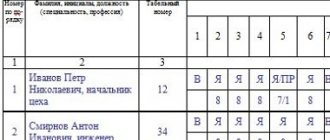The daily allowance is set by the organization
A business trip is a business trip of an employee outside the place of permanent work to carry out an official assignment (Article 166 of the Labor Code of the Russian Federation). Employees sent on a business trip must be reimbursed (Article 168 of the Labor Code of the Russian Federation):
- travel expenses;
- housing rental costs;
- daily allowance – additional expenses associated with living outside your permanent place of residence;
- other expenses incurred on a business trip in agreement with the administration.
The amount of daily allowance is not regulated by current legislation and remains at the discretion of the employer (Part 4 of Article 168 of the Labor Code of the Russian Federation). Typically, when setting daily allowances, organizations are guided by daily payment limits that are not subject to personal income tax and insurance contributions. Let us remind you that daily allowances up to 700 rubles/day for business trips within the Russian Federation and 2,500 rubles/day for business trips abroad are not subject to personal income tax and insurance contributions. However, linking the amount of daily allowance to the limit is not a dogma, and it can be set at any amount. The main thing is that they should not be less than the daily payments established for institutions financed from the budget (the daily allowance for employees of federal institutions is 100 rubles) (for more details, see “Daily allowance in 2018”).
What is a business trip under the Labor Code of the Russian Federation and what are its distinctive features
What is considered a business trip under the Labor Code of the Russian Federation? The provisions of the code say that a business trip is a trip by a company employee, which has a certain period and is carried out in accordance with the order of the employer, to an object that is located outside the regular place of work (Article 166 of the Labor Code of the Russian Federation). The Labor Code distinguishes between the concept of a business trip and a business trip - carried out by an employee in a position that involves performing work of a traveling nature.
A business trip is also considered a temporary departure of an employee to a structural unit of an organization located in another locality or abroad.
A business trip, unlike a business trip, requires registration in a special order - established by Decree of the Government of Russia dated October 13, 2008 No. 749. In practice, this means:
- issuance of a travel order by management;
- payment of an advance to the traveler;
- completion of an advance report by an employee returning from a business trip (as well as a job assignment and a business trip report, if this is provided for by the employer’s local regulations).
For posted workers, unlike those who participate in business trips, a wide range of guarantees and compensations has been established. The traveler's salary is calculated according to a special principle - based on average earnings.
You can learn more about the specifics of calculating salaries for employees on business trips in the article “Calculating average earnings for a business trip.”
Recording the working time of employees on a business trip also has its own peculiarities. Let's look at them.
Departure day and arrival day must be paid
As for the payment of daily allowances for the day of departure and day of arrival, they must certainly be paid regardless of what time the employee departed (arrived). This is explained as follows.
Day of departure on a business trip
The day of departure for a business trip is the day of departure of the vehicle that will take the employee to the place of business trip from the locality where his place of work is located. Even if a plane or train departs at 23:59, this day is considered the departure day. Therefore, the daily allowance for that day must be paid in full.
What are the minimum and maximum terms for a business trip established according to the Labor Code of the Russian Federation?
With regard to business trips, the Labor Code of the Russian Federation, as well as other regulations, does not establish a minimum or maximum duration.
In theory (and often in practice), employees can go on business trips for just one day. In this case, one-day business trips can be divided into 2 types:
- to places from where it is possible to return daily to the locality in which the business traveler works regularly;
- to regions from where daily return to the place of work is difficult or practically impossible (for example, to a northern city connected with the rest only by air traffic on irregular flights).
In the first case, the traveler is not paid daily allowance. In the second, they are paid for the day of the business trip and for the time spent on the road (clause 11 of the Regulations approved by Resolution 749).
If an employee is sent abroad for one day, then if it is possible to return daily from abroad, he is entitled to 50% of the daily allowance established by local regulations, paid for a two-day or longer business trip (clause 20 of the Regulations).
Of course, an employer can adopt standards at the local level that significantly improve the employee’s situation in comparison with current legislation (and pay amounts equivalent to daily allowance when sending an employee on any one-day business trips).
Certain nuances characterize the reflection of employer travel expenses within the framework of tax and accounting. Read about them in the articles:
- “Procedure for accounting for travel expenses in 2017”;
- "St. 264 Tax Code of the Russian Federation (2017): questions and answers.”
Daily allowance
Computational operations have special features when it comes to calculating daily allowances. These funds are intended to cover expenses incurred by the employee in another city. The amount needed by the person during the day is taken into account. This includes payment for food and accommodation, transportation to the place of performance of duties.
Payment is made based on the daily rate. The amount has a fixed expression. It is worth taking into account that contributions and taxes will not be charged on amounts that fit into the established limit. Including:
- for traveling around the country – no more than 700 rubles;
- when traveling to another state, the amount increases to 2500.
Daily allowances are calculated according to different rules than those applicable to calculating the average salary. The transfer is made every day, including forced stops and while on the road. This means that funds are subject to transfer on days classified as weekends.
It is stipulated that travel time should include movement from the place of work to the train stations. For example, if a person is actually on a business trip from the 2nd to the 6th, but leaves on the 1st and returns on the 8th, payment must be made for all days.
It is important to take into account that the funds are issued in the form of an advance, that is, before the employee travels to another area.
Calculation of business trips based on average hourly earnings
For employees with summarized working hours, business trip time is paid from their average hourly earnings. To do this, earnings for the billing period are divided by the number of hours worked during the billing period:
The amount of payment for a business trip in this case is determined as the employee’s average hourly earnings multiplied by the number of working hours during the business trip:
(Clause 13 of the Regulations on the specifics of the procedure for calculating average wages, approved by Decree of the Government of the Russian Federation of December 24, 2007 N 922)
Average hourly earnings are calculated in the Business Trip in the following cases:
- for employees with a summarized working time schedule;
- in the case of a non-full-day business trip, when on average you need to pay not for a whole working day, but only for a few hours.
Employee Lotosov L.L. A shift work schedule has been established, for which summarized working hours are kept. Lotosov L.L. was on a business trip from June 19 to June 23, 2021.
The employee has been working in the organization since May 2021, his earnings for the billing period amounted to 48,080 rubles, and he worked 188 hours.
To calculate average hourly earnings, earnings for the billing period are divided by the number of hours worked:
The average hourly earnings of an employee were: RUB 48,080. : 188 hours = 255.74 rubles.
The amount of payment for a business trip is obtained by multiplying the average hourly earnings by the number of hours during the business trip, according to the employee’s schedule:
Payment for the business trip will be: 255.74 rubles. x 24 hours = 6,137.76 rubles.
Checking the calculation of average earnings and the amount of payment for a business trip
In general, to pay for business trips, the average daily earnings for one working day are determined. To do this, the employee’s earnings for the billing period (12 months preceding the month the business trip began) are divided by the number of days worked during this period:
To calculate the amount of payment for a business trip, the average daily earnings received are multiplied by the number of working days on the employee’s schedule during the business trip:
(Clause 9 of the Regulations on the specifics of the procedure for calculating average wages, approved by Decree of the Government of the Russian Federation of December 24, 2007 N 922)
You can view and, if necessary, adjust the data for calculating average earnings in the form Entering data for calculating average earnings , which is called up by clicking the button with the image of a green pencil:
Manual adjustments on this form will be shown in bold and will only affect the calculation of that trip, i.e. For subsequent calculations based on the average, manual adjustments are not saved.
Detailed information on how average earnings were calculated can be obtained in the printed form Calculation of average earnings - example in PDF.
Details of the calculation of the amount of payment for a business trip can be seen in the printed form. Detailed calculation of charges - example in PDF.
Pionov O.I. was on a business trip from June 05 to June 09, 2021.
The employee worked the pay period (from June 2021 to May 2018) in full, his earnings were: salary payment - 540,000 rubles, bonuses - 54,000 rubles.
The first part of the printed form Detailed calculation of accruals provides summary data on the calculation of average earnings:
In the billing period, the employee worked 247 working days.
The employee's average daily earnings were: (540,000 rubles + 54,000 rubles): 247 days = 2,404.86 rubles.
The second part of the form explains how the amount of payment for the business trip was obtained:
To calculate payment for a business trip, the average daily earnings are multiplied by the number of working days on the employee’s schedule during the business trip. The employee works on a five-day work schedule, with 5 working days during the business trip.
Payment for the business trip period will be: RUB 2,404.86. x 5 days = 12,024.30 rub.




